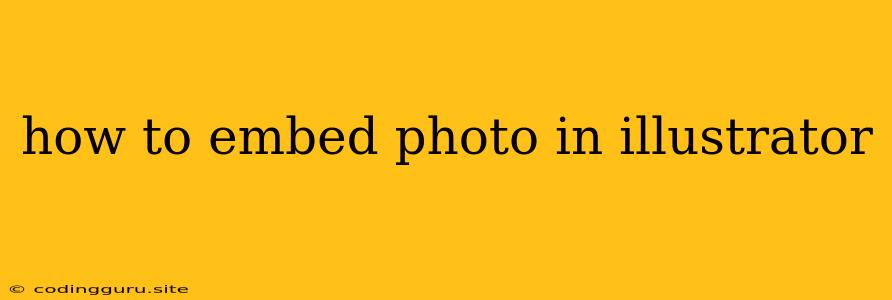How to Embed Photos in Illustrator: A Step-by-Step Guide
Illustrator is a powerful vector graphics editor that allows you to create stunning visuals, but often, you need to incorporate real-world images into your designs. This is where embedding photos comes in. Embedding photos in Illustrator ensures that the images are included within your artwork file, making it a self-contained unit. This is essential for maintaining the quality and integrity of your design, especially when sharing it with others or printing it.
Why Embed Photos in Illustrator?
There are several compelling reasons to embed photos in Illustrator:
- Maintaining Quality: When you embed a photo, it becomes part of the Illustrator file. This ensures that the image maintains its original quality regardless of where you save or share the file.
- Portability: You can easily share your Illustrator file without worrying about missing or corrupted image files. The embedded photo travels with the document, making it convenient for collaboration and distribution.
- Print-Readiness: When printing your Illustrator artwork, embedded photos guarantee that the images are printed at the correct resolution and color profile, ensuring a professional-looking final product.
How to Embed Photos in Illustrator
Here's a detailed guide on how to embed photos in Illustrator:
1. Open Your Illustrator File: Begin by opening the Illustrator file where you want to embed the photo.
2. Place the Photo:
- Drag and Drop: Simply drag the photo from your computer's file system onto the Illustrator canvas.
- File > Place: Navigate to File > Place and select the photo from your computer.
3. Choose the "Embed" Option: After placing the photo, a dialog box will appear. Select "Embed" from the options provided. This ensures the image is fully incorporated into your Illustrator file.
4. Optimize Image Settings (Optional):
- Image Trace: If you need to convert the image to vectors, use the Image Trace feature in Illustrator. This allows you to create editable outlines from your photo.
- Resizing: If necessary, resize the embedded photo by dragging its corner handles while holding down the Shift key to maintain its aspect ratio.
Important Considerations:
- Image Size and Resolution: Before embedding a photo, consider its size and resolution. Large, high-resolution images can significantly increase the file size of your Illustrator document, which may impact performance.
- File Format: It's recommended to embed photos in a lossless format like TIFF or PNG to preserve image quality.
- Image Optimization: If you're working with large images, you can optimize them for web use by reducing their file size while maintaining a good visual quality. You can use Illustrator's "Save for Web (Legacy)" feature for this purpose.
Tips for Effective Photo Embedding:
- Preview Before Embedding: Always preview the photo in Illustrator before embedding to ensure that it meets your requirements.
- Use Layers: Organize your artwork by placing embedded photos on separate layers for easier manipulation.
- Keep Files Organized: Maintain a consistent naming convention for your embedded photos for easier management.
Example: Embedding a Product Photo
Imagine you're creating an Illustrator document to showcase a new product. Here's how you'd embed a product photo:
- Open the Illustrator Document: Start with a new or existing Illustrator document.
- Place the Photo: Drag the product photo from your computer onto the Illustrator canvas or use File > Place.
- Embed the Photo: Select "Embed" in the dialog box that appears.
- Adjust Size and Position: Resize and position the photo to fit your layout using the selection tools.
Conclusion
Embedding photos in Illustrator is a crucial step in creating high-quality, self-contained design files. By following these steps and incorporating the tips provided, you'll ensure that your embedded photos maintain their original quality, enhance the portability of your artwork, and create professional-looking results, whether for print or digital use.
